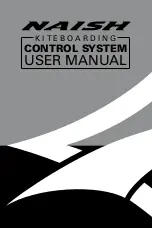
GDMMBi²13-1G
Version 0010
24
Figure 5-11
Figure 5-12
Slide the rest of the sail onto the leading edges.
Place another trestle under the end of the leading edges and remove the trestle from the
crossbar end area.
Remove the nose weight.
Slide the nose of the sail over the leading-edges/crossbar junctions and the keel.
Pass the hang-bracket through the nose of the sail. You may need to rotate the hang-bracket in
order to pass the sail over it.
Check for the keel reaching the hang-bracket position on the underside of the sail. The keel
needs to come out of the sail at this position, Figure 5-14. It may help to spread the wingtips
by about 1m around this point.
Figure 5-13
Figure 5-14
The sail should now be completely on the frame, with the wing tips close to the ends of the
sail. Check that all the tubes have passed down the leading edge side of the membrane.
Now remove the protective packing from the ends of the keel and leading-edges.
Thread a piece of string through the eyelets on the sail at the nose and tie to the nose plates.
3. Top Rigging
The upper rigging is attached to the king-post head and comprises two upper wing cross-
wires, the upper forward rigging wire, and the buckle of the luff line pulleys.
Lay out the upper rigging with the king-post upper fitting laid on top of the sail close to the
nose.
Thread the upper forward rigging wire down through the opening in the sail close to the nose
and to the rearmost bolt on the nose plate as shown in drawing
U028271-M030
.
Apply threadlock and tighten the nut, while still allowing rotation of the tang as usual.
Содержание BioniX2 13
Страница 42: ...GDMMBi 13 1G Version 0010 42...
Страница 48: ......
Страница 50: ...GDMMBi 13 1G Version 0010 50 Date Hours Flown Type of Operation Performed Operator Name Address Stamp...















































